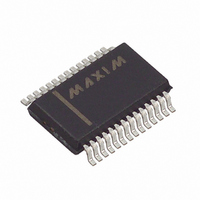MAX1407CAI+ Maxim Integrated Products, MAX1407CAI+ Datasheet - Page 22

MAX1407CAI+
Manufacturer Part Number
MAX1407CAI+
Description
IC DAS 16BIT LP 28-SSOP
Manufacturer
Maxim Integrated Products
Type
Data Acquisition System (DAS)r
Datasheet
1.MAX1409CAP.pdf
(48 pages)
Specifications of MAX1407CAI+
Resolution (bits)
16 b
Sampling Rate (per Second)
60
Data Interface
Serial
Voltage Supply Source
Analog and Digital
Voltage - Supply
2.7 V ~ 3.6 V
Operating Temperature
0°C ~ 70°C
Mounting Type
Surface Mount
Package / Case
28-SSOP
Number Of Converters
1
Resolution
16 bit
Interface Type
Serial (4-Wire, SPI, QSPI, Microwire)
Supply Voltage (max)
3.6 V
Supply Voltage (min)
2.7 V
Maximum Power Dissipation
762 mW
Maximum Operating Temperature
+ 70 C
Mounting Style
SMD/SMT
Minimum Operating Temperature
0 C
Lead Free Status / RoHS Status
Lead free / RoHS Compliant
Low-Power, 16-Bit Multichannel DAS with
Internal Reference,10-Bit DACs, and RTC
Figure 8. ADC Conversion Timing Diagram
The INT pin will also go low and stay low when the dif-
ferential voltage on the selected analog inputs exceeds
the signal-detect comparator trip threshold (0mV for the
MAX1407/MAX1408/MAX1409 and 50mV for the
MAX1414). This will latch the SDC bit of the Status reg-
ister to one. Additional signal detect interrupts cannot
be generated unless the SDC bit is cleared. To clear
the SDC bit, the Status register must be read and the
input must be below the signal-detect threshold.
Powering down the signal detect-comparator without
reading the Status register will also clear the SDC bit.
Similar to the power-up case, INT goes high when the
device detects a start bit through the serial interface
from the µP.
If the device is in Sleep mode, the alarm will wake up
the device and set the ALIRQ bit. INT is asserted when
the PLL is turned on. If an alarm occurs while the
device is awake (BIASE = 1), the ALIRQ bit will be set
and INT will go low. INT remains low until the device
detects a start bit through the serial interface from the
µP. ALIRQ is reset to 0 when any alarm register is read
or written to.
SHDN is an active-low output that can be used to con-
trol an external power supply. Powering up the PLL
(PLLE = 1) or writing a “1” to the SHDE bit of the
Power2 register causes SHDN to go high. SHDN goes
low when the SHDE bit is set to 0 only if the PLL is pow-
ered down (PLLE = 0). The SHDN output stays high for
2.93ms (t
allowing the external power supply to stay alive so that
the µP can properly complete a shutdown sequence.
22
DOUT
DRDY
SCLK
DIN
CS
______________________________________________________________________________________
DPD
1 0 A4 A3 A2 A1 A0 x
) after receiving a power-down command,
D7 D6 D5 D4 D3 D2 D1 D0
Shutdown ( S S H H D D N N )
Time of Day Alarm
CONV
ADC
Signal Detect
1 1 A4 A3 A2 A1 A0 x
SHDN is not available on the MAX1409. Note: Entering
Sleep mode automatically sets PLLE and SHDE to 0.
Any wake-up event will cause SHDN to go high. (See
Wake-Up section.)
This pin will go low and stay low upon completion of an
ADC conversion or end of an ADC calibration. This sig-
nals the µP that a valid conversion or calibration result
has been written to the DATA or the OFFSET register.
The DRDY pin goes high either when the µP has fin-
ished reading the conversion/calibration result on the
last rising edge of SCLK (see Figure 8), or when the
next conversion result is about to be written to the
DATA register. When no read operation is performed,
DRDY pulses at 60Hz with a pulse high time of
162.76µs (or 30Hz with a pulse high time of 325.52µs)
DRDY is not available on the MAX1409. To see when
the ADC has completed a normal conversion or a cali-
bration conversion for the MAX1409, check the status
of the ADD bit in the Status register.
The SPI/QSPI/MICROWIRE-serial interface consists of
chip select (CS), serial clock (SCLK), data in (DIN), and
data out (DOUT) (See Figure 9). The serial interface
provides access to 29 on-chip registers, allowing con-
trol to all the power modes and functional blocks,
including the ADCs, DACs, and RTC. Table 2 lists the
address and read/write accessibility of all the registers.
A logic high on CS three-states DOUT and causes the
MAX1407/MAX1408/MAX1409/MAX1414 to ignore any
signals on SCLK and DIN. To clock data into or out of
the internal shift register, drive CS low. SCLK synchro-
nizes the data transfer. The rising edge of SCLK clocks
DIN into the shift register, and the falling edge of SCLK
D15 D14 D13 D12 D11 D10
D9
Serial Digital Interface
D8
D7 D6 D5 D4 D3 D2 D1 D0
Data Ready ( D D R R D D Y Y )











